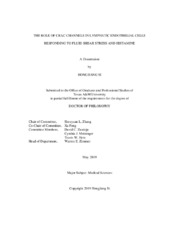| dc.description.abstract | The lymphatic system maintains body fluid homeostasis, lipid absorption, and immune surveillance by transporting fluid, macromolecules, and cells back to the circulatory system. Disrupted lymphatic integrity or pumping causes numerous severe diseases, including lymphedema and inflammatory disorders. Calcium (Ca^2^+) release-activated Ca^2^+ (CRAC) channels mediate the ubiquitous store-operated Ca^2^+ entry (SOCE) and are essential for various cellular processes (e.g., T cell activation, mast cell degranulation, and endothelial cell proliferation). However, the role of CRAC channels in the lymphatic system remains unclear. In this dissertation we addressed the function of CRAC channels in cultured lymphatic endothelial cells (LECs) responding to fluid shear stress (FSS) and histamine. In the model of FSS stimulation, we described the Ca 2+ dynamics triggered by FSS in LECs and determined the necessity of CRAC channels, formed by Orai1 and STIM1 proteins, in the Ca^2^+ signaling utilizing pharmacological blockers and RNA interference (RNAi). By using confocal imaging and RNAsequencing (RNA-Seq), we further found that the activation of nuclear factor of activated T-cells (NFAT) and transcriptional reprogramming downstream of FSS were also dependent on CRAC channels. Our quantitative PCR (qPCR) and enzyme-linked immunosorbent assay (ELISA) data also showed that blocking CRAC channels abolished the regulation of interleukin-8 (IL-8) secretion by FSS, indicating that CRACchannels are required in FSS-induced cytokine modulation. In addition, we studied the Ca^2^+ signaling in LECs upon histamine stimulation using single-cell Ca^2^++ imaging and discovered that histamine evoked the intracellular Ca^2^+ store release through H1 receptors (H1R) and phospholipase C (PLC). The subsequent sustained Ca^2^+ entry from the extracellular solution triggered by histamine was mediated by CRAC channels. We also examined the lymphatic endothelial barrier function after histamine stimulation and found that the hyperpermeability and VE-cadherin disruption caused by histamine was attenuated by CRAC channel blockers. Moreover, the knockdown of CRAC channels diminished the inflammatory cytokine expression after histamine stimulation in LECs. In summary, this study demonstrated the essential role of CRAC channels in both mechanotransduction and histamine-elicited inflammatory responses in LECs. | en |


